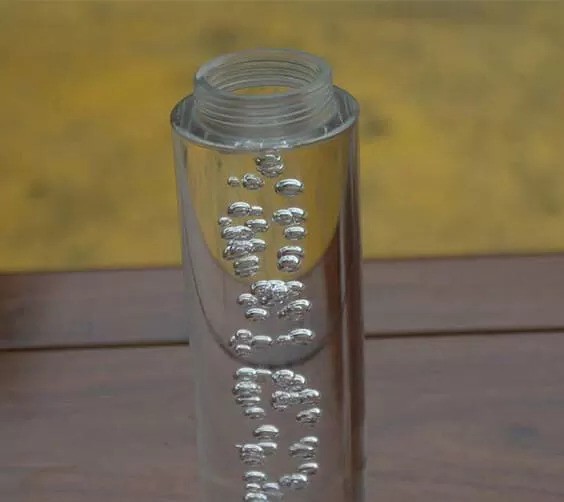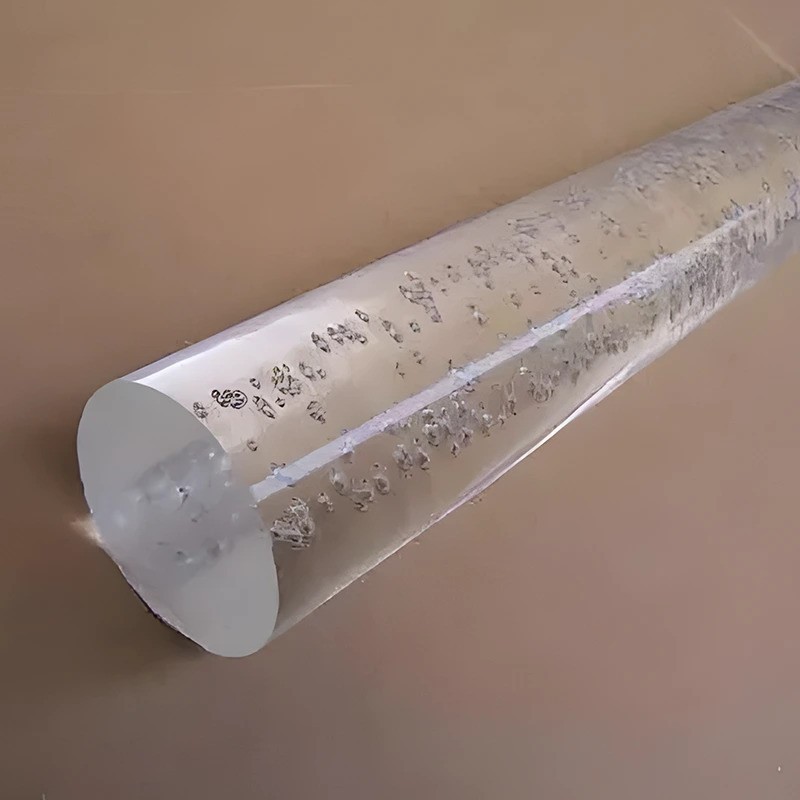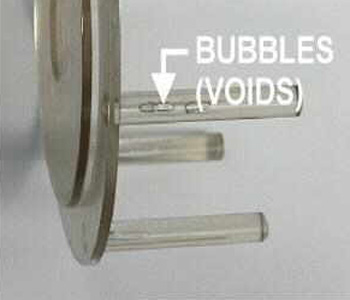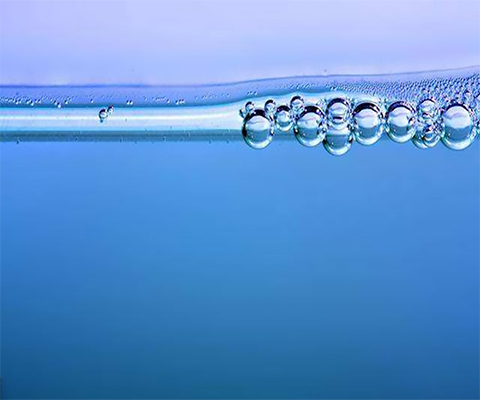Injection molding is crucial in manufacturing, creating products we use daily. However, bubbles can ruin quality and appearance. Understanding what causes bubbles—and how to fix them—is essential. In this post, you'll learn the main causes of bubbles in injection molding and practical solutions to eliminate them.
What are Bubbles in Injection Molding?
In injection molding, bubbles are empty spaces or voids that form within the plastic part during the molding process. They can appear on the surface or be trapped inside the part. Bubbles are one of the common injection molding defects that manufacturers need to address.
Bubbles come in two main types:
Vacuum voids: These form when gases can't escape the mold cavity fast enough. The trapped air creates a bubble.
Gas bubbles: These happen due to the thermal breakdown of the plastic material. The heat causes the resin to give off gases, which get trapped as bubbles.

During injection molding, bubbles typically form when:
The mold doesn't have proper venting channels
Injection speeds are too high, trapping air
Melt temperatures are too high, causing the plastic to degrade and give off gas
There's moisture in the raw material that turns to steam
You can usually spot bubbles by looking closely at the part. They'll appear as:
Raised bumps or blisters on the surface
Visible air pockets just below the surface
Voids deep within transparent parts
Bubbles are more than just cosmetic flaws. They can also:
Weaken the structural integrity of the part
Create leak paths in fluid-handling components
Interfere with light transmission in optical parts
It's important to note that bubbles can sometimes be confused with other injection molding defects like sink marks or warping. Proper identification is crucial for effective troubleshooting and resolution.
Causes of Bubbles in Injection Molding
Bubbles can form in injection molded parts for many reasons. Let's break it down by category:
Machine-related Causes
The injection molding machine itself can contribute to bubble formation. Here are some key factors:
Low injection pressure or hold time: If the pressure is too low or the hold time too short, the melt may not fully pack out the mold cavity, leaving room for bubbles. This is similar to short shot defects in injection molding.
Insufficient material feed: If the machine doesn't deliver enough plastic to fill the mold, it can result in voids.
Improper injection temperature profile: If the barrel temperatures are set incorrectly, it can cause the melt to degrade or flow poorly, leading to trapped gases.
Excessive injection speed: Injecting the melt too quickly can cause turbulence, whipping air into the plastic.
Insufficient back pressure: Too little back pressure can allow air to mix into the melt during screw recovery.
Mold-related Causes
The design and condition of the mold also play a role in bubble formation:
Improper venting design: If the mold lacks adequate venting channels or the vents are too small, gases can't escape and will be trapped in the part.
Thick wall sections: Thicker areas of the part take longer to cool and solidify, giving bubbles more time to form. This can also lead to sink marks in injection molding.
Improper runner or gate design: Poorly designed runner systems or gate locations can lead to uneven filling and air entrapment.
Low mold temperature: If the mold steel is too cold, the plastic will freeze off quickly, trapping any bubbles that have formed.
Material-related Causes
The raw materials and additives used can also contribute to bubbles:
Excessive moisture content: If hygroscopic resins aren't properly dried before molding, the moisture will turn to steam and cause bubbles.
Contamination or poor quality raw materials: Dirty or degraded raw materials can introduce contaminants that nucleate bubbles.
Excessive use of recycled material: Recycled plastics tend to have more moisture and contaminants that can cause bubbles.
Presence of volatile additives or uneven mixing: If colorants, lubricants, or other additives aren't fully dispersed, they can create localized areas of off-gassing.
Process-related Causes
The way the molding process is set up and run can also lead to bubble issues:
Inconsistent process cycle: Variations in shot size, injection speed, packing pressure, or cooling time can cause intermittent bubble formation.
High melt temperature causing degradation: If the plastic gets too hot, it can start to break down and give off gases.
Insufficient drying of hygroscopic materials: Failing to remove moisture from the raw material will almost always cause bubbles.
Fast injection speed causing turbulent flow: Injecting too quickly can cause the melt to flow erratically and trap air pockets. This can also lead to flow lines defects in injection molding.
Poor gate location or small gate size: If the melt has to flow too far or through a restrictive gate, it can lose heat and solidify before pushing all the air out.
Slow injection speed: On the other hand, if you inject too slowly, the material in contact with the mold wall may cool and freeze off before the cavity is fully packed, trapping voids.
Short cooling time: Especially with thick parts, insufficient cooling can allow bubbles to grow as the part solidifies from the outside in. In these cases, extra cooling measures like cold water or compressed air may be needed.
Operator-related Causes
Finally, the actions of the molding machine operator can influence bubble formation:
Understanding these causes is crucial for troubleshooting and preventing injection molding defects, including bubbles and other issues like warping in injection molding.

Solutions for Eliminating Bubbles in Injection Molding
Now that we know what causes bubbles, let's look at how to get rid of them. We'll cover solutions in four key areas:
Machine Adjustments
Fine-tuning your injection molding machine settings can go a long way towards eliminating bubbles:
Increase injection pressure and hold time: Higher pressure and longer hold times help ensure the melt completely fills the mold and packs out any voids.
Ensure proper material feed and cushion: Make sure the machine is delivering a consistent shot size with a small cushion of extra material to maintain packing pressure.
Optimize injection temperature profile: Adjust barrel temperatures to keep the melt within the recommended processing window for the material, promoting good flow without degradation.
Adjust injection speed based on material and part design: Slower speeds for thicker or more complex parts can prevent turbulence and air entrapment.
Set appropriate back pressure: Maintain enough back pressure to ensure a homogeneous melt without entrapping air during screw recovery.
Mold Design Improvements
Optimizing your mold design can prevent bubbles from forming in the first place:
Incorporate proper venting channels and exhaust pins: Add ample venting to allow trapped air to escape as the melt fills the cavity.
Optimize wall thickness and avoid thick sections: Design parts with uniform wall thickness to promote even cooling and solidification, reducing the risk of voids.
Redesign runners and gates for better flow: Make sure your runner system and gate locations promote balanced, laminar flow into the cavity.
Maintain suitable mold temperature: Keep the mold surface hot enough to prevent the melt from freezing off before it's fully packed out.
Consider proper draft angles: Correct draft angles can help with part ejection and reduce the risk of trapped air.
Material Preparation and Handling
Proper material management is critical for avoiding bubble-causing contamination and moisture:
Thoroughly dry hygroscopic materials before processing: Use a desiccant dryer to remove moisture from materials like nylon, PC, and PET.
Avoid contamination and ensure high-quality raw materials: Keep your resin clean and free of foreign particles that could nucleate bubbles.
Limit the use of recycled material: If you must use regrind, keep it clean and dry, and limit it to a small percentage of the total shot.
Carefully control the addition of volatile additives: Make sure any colorants, lubricants, or other additives are thoroughly mixed and don't introduce excess moisture or gases.
Process Optimization Techniques
Finally, dialing in your process parameters and techniques can help eliminate bubble formation:
Maintain consistent process cycle and minimize variations: Use process monitoring and control systems to keep your shot size, injection speed, pressures, and temperatures consistent from cycle to cycle.
Avoid excessive melt temperatures and material degradation:
Lower barrel temperatures within recommended range: If you're seeing signs of material degradation, lower your barrel temperatures, but keep them within the material supplier's recommended processing window.
Follow proper drying procedures for hygroscopic resins: Make sure you're drying materials at the correct temperature and for long enough to remove all excess moisture.
Adjust injection speed to achieve laminar flow:
Optimize gate location and size through flow analysis: Use mold filling simulation software to find the best gate locations and sizes for balanced, bubble-free filling.
Increase holding pressure and time to solve gas obstruction: Higher packing pressures and longer hold times can help force trapped gases out of the mold.
| Category | Cause | Solution |
| Machine | Improper injection pressure, speed, or temperature | Optimize machine settings based on material and part design |
| Mold | Poor venting, thick walls, improper gate/runner design | Improve venting, optimize wall thickness, redesign gates/runners |
| Material | Moisture, contamination, recycled material, additives | Dry materials, ensure quality, limit regrind, control additives |
| Process | Inconsistent cycle, high melt temp, insufficient drying | Maintain consistent process, avoid degradation, proper drying |
| Operator | Improper operation, unstable parameters | Ensure consistent operation, minimize variations |
| Equipment | Nozzle/barrel issues, frictional heat | Maintain equipment, control injection speed |
| Raw Material | Foreign materials, contamination, volatiles | Ensure clean, high-quality raw materials |
Preventive Measures to Avoid Bubbles
While it's important to know how to troubleshoot bubbles when they occur, it's even better to prevent them from forming in the first place. Let's explore some key strategies for bubble prevention.

Best Practices in Material Handling and Preparation
Proper material management is critical for avoiding moisture-related bubbles. Here are some tips:
Design Considerations to Minimize Bubble Formation
Optimizing your part and mold design can help prevent bubbles from forming:
Implementing a Full Prevention Strategy
For the best results, take a holistic approach to bubble prevention:
| Bubble Prevention Strategy | Key Elements |
| Material Handling | Proper storage, drying, moisture monitoring |
| Process Optimization | Consistent parameters, avoid degradation, laminar flow |
| Mold Design | Smooth surfaces, rounded corners, optimized gating |
| Holistic Approach | Combine strategies, continuous monitoring and adjustment |

Conclusion
In this article, we've explored the common causes of bubbles in injection molding, including machine, mold, material, process, and operator factors. We've also discussed practical solutions for eliminating bubbles, such as optimizing machine settings, improving mold design, properly preparing materials, and fine-tuning process parameters.
To effectively eliminate bubbles, it's crucial to take a holistic approach. This involves conducting systematic cause analysis, implementing targeted solutions, and maintaining long-term monitoring and optimization of the injection molding process.
By producing bubble-free parts, manufacturers can improve product quality, shorten cycle times, reduce costs, and increase overall production efficiency. Continuous improvement and optimization are key to achieving consistent, high-quality results in injection molding.
If you have any questions or need assistance with bubble issues in your injection molded parts, please don't hesitate to reach out to our expert team at Team Mfg. We're here to help you optimize your process and achieve the highest quality results. Contact us today to learn more.













